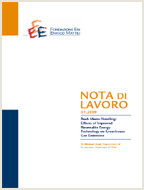Deforestation Rate in the Long-run: the Case of Brazil

24.08.2016
Luca Di Corato (Swedish University of Agricultural Sciences); Michele Moretto (University of Padova, Fondazione Eni Enrico Mattei, Centro Studi Levi-Cases); Sergio Vergalli (University of Brescia, Fondazione Eni Enrico Mattei)
C61, D81, Q24, Q58
Deforestation, Long-run, Natural Resources Management, Optimal Stopping
Climate Change: Economic Impacts and Adaptation
Francesco Bosello
In this article we study the long-run average rate of forest conversion in Brazil. Deforestation results from the following trade-off: on the one hand, the uncertain value of benefits associated with forest conservation (biodiversity, carbon sequestration and other ecosystem services), on the other hand, the economic profits associated with land development (agriculture, ranching, etc.). We adopt the model by Bulte et al. (2002) as theoretical frame for studying land conversion and then derive, following Di Corato et al. (2013), the associated long-run average rate of forest conversion. We then identify the parameters to be used in our model. The object of our simulation is Brazil and 27 states. Our aim is to compute under several scenarios the time required to develop the remaining forested land in these states. We provide potential future scenarios, in terms of forest coverage, for the next 20, 100 and 200 years. Our results suggest that the uncertainty characterizing forest benefits plays a relevant role in deterring deforestation. We find that these benefits, if growing at a sufficiently high rate, may significantly slow down the conversion process. In contrast, a higher volatility accelerates the process of deforestation. We indicate the Brazilian states where forests are expected to be saturated earlier. In this respect, we find that forestland currently available may be expected to be fully converted within a 200-year horizon.
***
Suggested citation: Di Corato, L., M. Moretto, S. Vergalli, (2016), ‘Deforestation Rate in the Long-run: the Case of Brazil’, Nota di Lavoro 56.2016, Milan, Italy: Fondazione Eni Enrico Mattei
